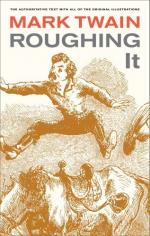Of course these mines cave in, in places, occasionally, and then it is worth one’s while to take the risk of descending into them and observing the crushing power exerted by the pressing weight of a settling mountain. I published such an experience in the Enterprise, once, and from it I will take an extract:
An hour in the caved mines.—We journeyed down into the Ophir mine, yesterday, to see the earthquake. We could not go down the deep incline, because it still has a propensity to cave in places. Therefore we traveled through the long tunnel which enters the hill above the Ophir office, and then by means of a series of long ladders, climbed away down from the first to the fourth gallery. Traversing a drift, we came to the Spanish line, passed five sets of timbers still uninjured, and found the earthquake. Here was as complete a chaos as ever was seen—vast masses of earth and splintered and broken timbers piled confusedly together, with scarcely an aperture left large enough for a cat to creep through. Rubbish was still falling at intervals from above, and one timber which had braced others earlier in the day, was now crushed down out of its former position, showing that the caving and settling of the tremendous mass was still going on. We were in that portion of the Ophir known as the “north mines.” Returning to the surface, we entered a tunnel leading into the Central, for the purpose of getting into the main Ophir. Descending a long incline in this tunnel, we traversed a drift or so, and then went down a deep shaft from whence we proceeded into the fifth gallery of the Ophir. From a side-drift we crawled through a small hole and got into the midst of the earthquake again—earth and broken timbers mingled together without regard to grace or symmetry. A large portion of the second, third and fourth galleries had caved in and gone to destruction—the two latter at seven o’clock on the previous evening.
At the turn-table, near the northern extremity of the fifth gallery, two big piles of rubbish had forced their way through from the fifth gallery, and from the looks of the timbers, more was about to come. These beams are solid—eighteen inches square; first, a great beam is laid on the floor, then upright ones, five feet high, stand on it, supporting another horizontal beam, and so on, square above square, like the framework of a window. The superincumbent weight was sufficient to mash the ends of those great upright beams fairly into the solid wood of the horizontal ones three inches, compressing and bending the upright beam till it curved like a bow. Before the Spanish caved in, some of their twelve-inch horizontal timbers were compressed in this way until they were only five inches thick! Imagine the power it must take to squeeze a solid log together in that way. Here, also, was a range of timbers, for a distance of twenty feet, tilted




